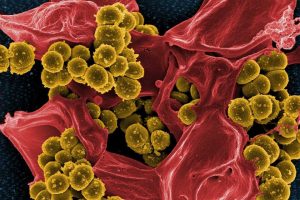Emerging superbug MRSA in humans found in urban hedgehogs in Finland


For the first time, a highly transmissible strain of the antibiotic-resistant superbug MRSA currently plaguing hospitals in Northern Europe has been isolated from hedgehogs in Helsinki. The study by Venla Johansson and colleagues from the University of Helsinki, Finland, is to be presented at this year’s European Congress of Clinical Microbiology & Infectious Diseases (ECCMID) in Lisbon, Portugal (23-26 April).
The researchers say that the findings suggest a spillover of antimicrobial resistant (AMR) bacteria and genes to urban wildlife and should be closely monitored to limit the global emergence of novel antimicrobial resistance traits in the future.
Superbugs such as Methicillin-resistant Staphylococcus aureus (MRSA) are antibiotic-resistant bacteria for which there are limited or no treatments. European hedgehogs (Erinaceus europaeus) are common wild species living in urban areas, and were recently found to be a natural reservoir of MRSA. Surveys in Denmark and Sweden also suggest that up to 60% of hedgehogs carry a type of MRSA called mecC-MRSA, which causes 1 in 200 of all MRSA infections in humans.
Escherichia coli (E. coli) and Klebsiella pneumoniae bacteria are common in the intestines of healthy people and animals. Highly resistant strains with extended spectrum beta-lactamase-producing Enterobacteriaceae (ESBL-E) commonly cause urinary tract infections in people. Previous studies have found ESBL-E are common in wild European hedgehog populations. But little is known about Finnish hedgehogs as reservoirs of AMR bacteria or genes.
To find out the occurrence of these resistant bacteria in European hedgehogs in Finland, researchers tested samples from 115 dead hedgehogs from the Korkeasaari Zoo Wild Animal Hospital in Helsinki between 2020 and 2021.
To test for the presence of MRSA, nasal, oral and perineum swabs were obtained from each hedgehog, and stool samples were also collected to test for ESBL-E. Then whole genome sequencing was done to study the genomic features of the bacteria including virulence and resistant genes.
The research team found that around 1 in 10 (10%; 11/115) hedgehogs were colonized with at least one MRSA-producing bacterial strain and at least one ESBL-producing strain (9%; 10/115).
Interestingly, four hedgehogs carried mecA-MRSA and belonged to a successful clone (t304/ST6), that has been emerging in human patients in Northern Europe over the last few years. In Finland, most of the clinical MRSA infections are caused by mecA-MRSA.
However, only three hedgehogs carried the type of MRSA called mecC-MRSA, which has previously been reported to be commonly found in European hedgehogs in Sweden and Denmark. This suggests that there seems to be genetic diversity between, and variation in, MRSA strains over hedgehog populations and countries, say researchers.
The study also found that the most commonly occurring ESBL resistance genes were blaCTX-M-1 and blaCTX-M-15, that are frequently found in human and animal isolates. Worldwide spread of blaNDM-1 and other antibiotic-resistant genes is a growing concern because they often target “last resort” classes of antibiotics, including Carbapenem.
Moreover, two E. coli strains identified in hedgehogs were human-associated types (ST68 and ST69—a frequent cause of serious bladder and bloodstream infections in people), suggesting that they could have transferred from humans to hedgehogs.
“This is the first report of the successful t304/ST6 clone (with the capability of global spread) in urban hedgehogs and underscores the need for additional monitoring of possible t304/ST6 sources and its spread in urban environments”, says Johansson. “However, the clinical importance of the zoonotic potential, or whether mecA-MRSA in hedgehogs are of clinical concern to the animals themselves, is not known.”
She continues, “It is striking that we also found around 10% of hedgehogs were positive for ESBL-E-producing bacteria—double the prevalence in humans and companion animals in Finland (5%). Our findings could indicate a spillover of antimicrobial resistance from anthropogenic sources to urban wildlife, possibly creating secondary reservoirs in the environment from where clinically significant resistance may spread elsewhere.”
However, Johansson notes that it’s not just hedgehogs that harbor antibiotic-resistant bacteria, “All wildlife and livestock carry many different types of bacteria, so there are many candidates for its dispersal in urban environments including humans themselves. Moreover, anthropogenic sources, such as waste, agriculture runoff and domestic wastewater have been linked to antimicrobial resistance transmission to wild animals.”
This observational study cannot prove that anthropogenic sources cause colonization with AMR bacteria in Finnish hedgehogs, but only suggests the possibility of such an effect. The authors point to several limitations, including that they only sampled hedgehogs from one city in Finland and the findings might not be representative of the whole country.
Source: Read Full Article